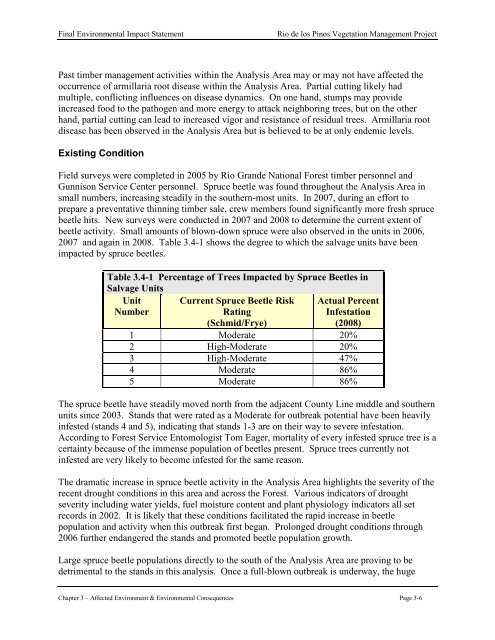Final Environmental Impact Statement Rio de los Pinos Vegetation ...
Final Environmental Impact Statement Rio de los Pinos Vegetation ...
Final Environmental Impact Statement Rio de los Pinos Vegetation ...
Create successful ePaper yourself
Turn your PDF publications into a flip-book with our unique Google optimized e-Paper software.
<strong>Final</strong> <strong>Environmental</strong> <strong>Impact</strong> <strong>Statement</strong> <strong>Rio</strong> <strong>de</strong> <strong>los</strong> <strong>Pinos</strong> <strong>Vegetation</strong> Management Project<br />
Past timber management activities within the Analysis Area may or may not have affected the<br />
occurrence of armillaria root disease within the Analysis Area. Partial cutting likely had<br />
multiple, conflicting influences on disease dynamics. On one hand, stumps may provi<strong>de</strong><br />
increased food to the pathogen and more energy to attack neighboring trees, but on the other<br />
hand, partial cutting can lead to increased vigor and resistance of residual trees. Armillaria root<br />
disease has been observed in the Analysis Area but is believed to be at only en<strong>de</strong>mic levels.<br />
Existing Condition<br />
Field surveys were completed in 2005 by <strong>Rio</strong> Gran<strong>de</strong> National Forest timber personnel and<br />
Gunnison Service Center personnel. Spruce beetle was found throughout the Analysis Area in<br />
small numbers, increasing steadily in the southern-most units. In 2007, during an effort to<br />
prepare a preventative thinning timber sale, crew members found significantly more fresh spruce<br />
beetle hits. New surveys were conducted in 2007 and 2008 to <strong>de</strong>termine the current extent of<br />
beetle activity. Small amounts of blown-down spruce were also observed in the units in 2006,<br />
2007 and again in 2008. Table 3.4-1 shows the <strong>de</strong>gree to which the salvage units have been<br />
impacted by spruce beetles.<br />
Table 3.4-1 Percentage of Trees <strong>Impact</strong>ed by Spruce Beetles in<br />
Salvage Units<br />
Unit<br />
Number<br />
Current Spruce Beetle Risk<br />
Rating<br />
(Schmid/Frye)<br />
Actual Percent<br />
Infestation<br />
(2008)<br />
1 Mo<strong>de</strong>rate 20%<br />
2 High-Mo<strong>de</strong>rate 20%<br />
3 High-Mo<strong>de</strong>rate 47%<br />
4 Mo<strong>de</strong>rate 86%<br />
5 Mo<strong>de</strong>rate 86%<br />
The spruce beetle have steadily moved north from the adjacent County Line middle and southern<br />
units since 2003. Stands that were rated as a Mo<strong>de</strong>rate for outbreak potential have been heavily<br />
infested (stands 4 and 5), indicating that stands 1-3 are on their way to severe infestation.<br />
According to Forest Service Entomologist Tom Eager, mortality of every infested spruce tree is a<br />
certainty because of the immense population of beetles present. Spruce trees currently not<br />
infested are very likely to become infested for the same reason.<br />
The dramatic increase in spruce beetle activity in the Analysis Area highlights the severity of the<br />
recent drought conditions in this area and across the Forest. Various indicators of drought<br />
severity including water yields, fuel moisture content and plant physiology indicators all set<br />
records in 2002. It is likely that these conditions facilitated the rapid increase in beetle<br />
population and activity when this outbreak first began. Prolonged drought conditions through<br />
2006 further endangered the stands and promoted beetle population growth.<br />
Large spruce beetle populations directly to the south of the Analysis Area are proving to be<br />
<strong>de</strong>trimental to the stands in this analysis. Once a full-blown outbreak is un<strong>de</strong>rway, the huge<br />
Chapter 3 – Affected Environment & <strong>Environmental</strong> Consequences Page 3-6
















